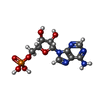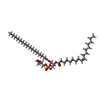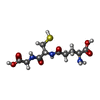+Search query
-Structure paper
| Title | Structure and mechanism of the K/H exchanger KefC. |
|---|---|
| Journal, issue, pages | Nat Commun, Vol. 15, Issue 1, Page 4751, Year 2024 |
| Publish date | Jun 4, 2024 |
 Authors Authors | Ashutosh Gulati / Surabhi Kokane / Annemarie Perez-Boerema / Claudia Alleva / Pascal F Meier / Rei Matsuoka / David Drew /  |
| PubMed Abstract | Intracellular potassium (K) homeostasis is fundamental to cell viability. In addition to channels, K levels are maintained by various ion transporters. One major family is the proton-driven K efflux ...Intracellular potassium (K) homeostasis is fundamental to cell viability. In addition to channels, K levels are maintained by various ion transporters. One major family is the proton-driven K efflux transporters, which in gram-negative bacteria is important for detoxification and in plants is critical for efficient photosynthesis and growth. Despite their importance, the structure and molecular basis for K-selectivity is poorly understood. Here, we report ~3.1 Å resolution cryo-EM structures of the Escherichia coli glutathione (GSH)-gated K efflux transporter KefC in complex with AMP, AMP/GSH and an ion-binding variant. KefC forms a homodimer similar to the inward-facing conformation of Na/H antiporter NapA. By structural assignment of a coordinated K ion, MD simulations, and SSM-based electrophysiology, we demonstrate how ion-binding in KefC is adapted for binding a dehydrated K ion. KefC harbors C-terminal regulator of K conductance (RCK) domains, as present in some bacterial K-ion channels. The domain-swapped helices in the RCK domains bind AMP and GSH and they inhibit transport by directly interacting with the ion-transporter module. Taken together, we propose that KefC is activated by detachment of the RCK domains and that ion selectivity exploits the biophysical properties likewise adapted by K-ion-channels. |
 External links External links |  Nat Commun / Nat Commun /  PubMed:38834573 / PubMed:38834573 /  PubMed Central PubMed Central |
| Methods | EM (single particle) |
| Resolution | 3.16 - 3.18 Å |
| Structure data | EMDB-16318: Structure of the K/H exchanger KefC EMDB-16319: Structure of the K+/H+ exchanger KefC with GSH |
| Chemicals |  ChemComp-K:  ChemComp-AMP:  ChemComp-PGW:  ChemComp-GSH: |
| Source |
|
 Keywords Keywords | MEMBRANE PROTEIN / potassium proton exchanger / KefC / Transporter / CPA / GSH |
 Movie
Movie Controller
Controller Structure viewers
Structure viewers About Yorodumi Papers
About Yorodumi Papers








